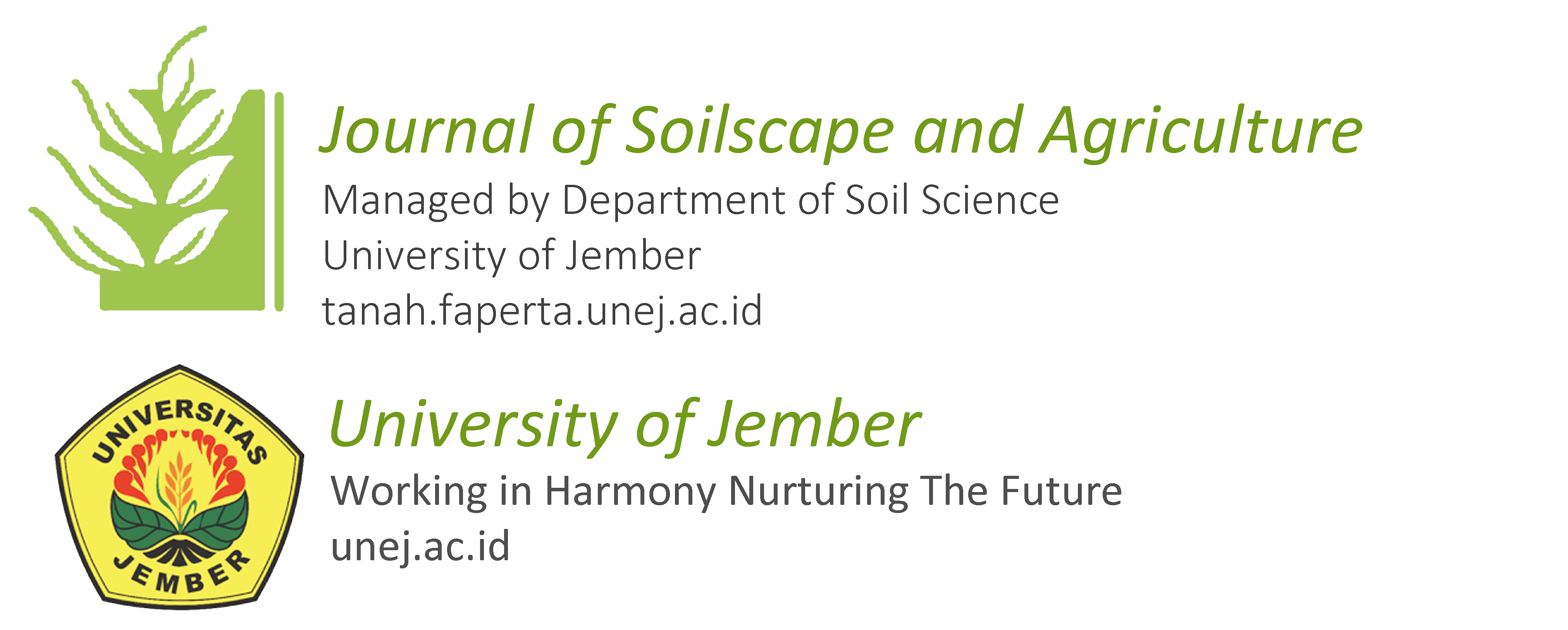Evaluating the Potential of Dragon Fruit Cultivation in Banyuwangi District Based on Land Suitability
DOI:
https://doi.org/10.19184/jsa.v2i2.942Keywords:
land suitability, horticulture, dragon fruitAbstract
Among the horticulture commodities with development potential are fruit plants. Purposive sampling was the method used for sampling. With the exception of land uses like mining and settlements, sample points were chosen depending on land use. Each unit of land map created by land resource surveying and mapping activities has features, such as soil characteristics and physical environment features, that can be specifically defined as land characteristics. The purpose of this study is to investigate how suitable the terrain is for growing dragon fruit in the Banyuwangi Regency. This study used a survey methodology with land units serving as the analytical unit. Land units for this study were derived from the slope and overlap of land use maps. With an area coverage of 251,527 Ha, or 42.6%, the majority of Banyuwangi Regency is classified as having land suitability class S1 (very suitable), meaning that it does not have significant barriers to sustainable use or only minor ones that have no discernible impact on production or require an increase in input. Thus, it is critical to conduct this research in order to accurately evaluate the appropriateness of the site and enable the implementation of optimal land management strategies that will boost dragon fruit yield and lower production costs
References
Abd El-Maaboud, I. M. A., Abbas, H. H., Rashed, H. S. A., Zahra, W. R., Afify, A. A., Al-Shami, A. S. A., & Hassan, F. O. (2019). Land Suitability Analyses for Cultivating Certain Crops in Some Wadies of Southwest Sinai, Egypt, Using Remote Sensing Data and Gis Technique. Egypt. J. of Appl. Sci., 33(5), 184–202.
Abdullah, N., Zolkafli, A., Mansor, N. S., & Chik, N. A. (2020). Farmer’s knowledge in land suitability evaluation and farmers’ awareness in organic farming for sustainable agriculture: A case study in perlis. IOP Conference Series: Earth and Environmental Science, 616(1). https://doi.org/10.1088/1755-1315/616/1/012041
Aldababseh, A., Temimi, M., Maghelal, P., Branch, O., & Wulfmeyer, V. (2018). Multi-criteria evaluation of irrigated agriculture suitability to achieve food security in an arid environment. Sustainability (Switzerland), 10(3). https://doi.org/10.3390/su10030803
Andrea, R., Aliyah, I., & Yudana, G. (2021). Studi kesesuaian lahan pertanian sawah organik (Studi kasus: Desa Gempol, Kabupaten Klaten). Region : Jurnal Pembangunan Wilayah Dan Perencanaan Partisipatif, 16(2), 333. https://doi.org/10.20961/region.v16i2.25468
Dharumarajan, S., Kalaiselvi, B., Lalitha, M., Vasundhara, R., & Hegde, R. (2022). Defining fertility management units and land suitability analysis using digital soil mapping approach. Geocarto International, 37(20), 5914–5934. https://doi.org/10.1080/10106049.2021.1926553
Han, C., Chen, S., Yu, Y., Xu, Z., Zhu, B., Xu, X., & Wang, Z. (2021). Evaluation of agricultural land suitability based on RS, AHP, and MEA: A case study in Jilin province, China. Agriculture (Switzerland), 11(4). https://doi.org/10.3390/agriculture11040370
Hartati, T. M., Sunarminto, B. H., & Nurudin, M. (2018). Evaluasi Kesesuaian Lahan untuk Tanaman Perkebunan di Wilayah Galela, Kabupaten Halmahera Utara, Propinsi Maluku Utara. Caraka Tani: Journal of Sustainable Agriculture, 33(1), 68. https://doi.org/10.20961/carakatani.v33i1.19298
Kahsay, A., Haile, M., Gebresamuel, G., & Mohammed, M. (2018). Land suitability analysis for sorghum crop production in northern semi-arid Ethiopia: Application of GIS-based fuzzy AHP approach. Cogent Food and Agriculture, 4(1), 1–24. https://doi.org/10.1080/23311932.2018.1507184
Karimi, F., Sultana, S., Shirzadi Babakan, A., & Royall, D. (2018). Land Suitability Evaluation for Organic Agriculture of Wheat Using GIS and Multicriteria Analysis. Papers in Applied Geography, 4(3), 326–342. https://doi.org/10.1080/23754931.2018.1448715
Mugiyo, H., Chimonyo, V. G. P., Sibanda, M., Kunz, R., Masemola, C. R., Modi, A. T., & Mabhaudhi, T. (2021). Evaluation of land suitability methods with reference to neglected and underutilised crop species: A scoping review. Land, 10(2), 1–24. https://doi.org/10.3390/land10020125
Neswati, R., Baja, S., & Lopulisa, C. (2021). A modification of land suitability requirements for maize in the humid tropics of South Sulawesi. IOP Conference Series: Earth and Environmental Science, 921(1). https://doi.org/10.1088/1755-1315/921/1/012012
Noorollahi, E., Fadai, D., Shirazi, M. A., & Ghodsipour, S. H. (2016). Land suitability analysis for solar farms exploitation using GIS and fuzzy analytic hierarchy process (FAHP) - A case study of Iran. Energies, 9(8), 1–24. https://doi.org/10.3390/en9080643
Rasheed, H., & Naz, A. (2017). Modeling the Rice Land Suitability Using GIS and Multi-Criteria Decision Analysis Approach in Sindh, Pakistan. Journal of Basic & Applied Sciences, 13, 26–33.
Romadhona, S., & Arifandi, J. A. (2020). Indeks Kualitas Tanah Dan Pemanfaatan Lahan Sub Daerah Aliran Sungai Suco Kabupaten Jember. Geography: Jurnal Kajian, Penelitian Dan Pengembangan Pendidikan, 8(1), 37–45.
Romadhona, S., Sri Puryono, K. S., & Mussadun. (2023). Assessment of the potential of organic land for food crops and horticulture in the tropical areas to support SDGS. IOP Conference Series: Earth and Environmental Science, 1266(1). https://doi.org/10.1088/1755-1315/1266/1/012028
Sofyan, R., Wahyunto, Agus, F., & Hidayat, H. (2007). Panduan Evaluasi Kesesuaian Lahan. Balai Penelitian Tanah Dan World Agroforestry Centre, 48. www.worldagroforestrycentre.org/sea.
Sumani, Mujiyo, Winarno, J., Widijanto, H., & Hasanah, K. (2018). Land suitability evaluation for sweet corn in third cropping period at Wonosari Village, Karanganyar, Indonesia. IOP Conference Series: Earth and Environmental Science, 200(1). https://doi.org/10.1088/1755-1315/200/1/012007
Syamsiyah, K. N., & Wicaksono, K. S. (2023). Evaluasi Retensi Hara Pada Lahan Padi Di Kabupaten Pamekasan. Jurnal Tanah Dan Sumberdaya Lahan, 10(1), 175–184. https://doi.org/10.21776/ub.jtsl.2023.010.1.20
Taghizadeh-Mehrjardi, R., Nabiollahi, K., Rasoli, L., Kerry, R., & Scholten, T. (2020). Land suitability assessment and agricultural production sustainability using machine learning models. Agronomy, 10(4), 1–20. https://doi.org/10.3390/agronomy10040573
Zakarya, Y. M., Metwaly, M. M., Abdelrahman, M. A. E., Metwalli, M. R., & Koubouris, G. (2021). Optimized land use through integrated land suitability and gis approach in west el-minia governorate, upper Egypt. Sustainability (Switzerland), 13(21), 1–21. https://doi.org/10.3390/su132112236
Downloads
Published
How to Cite
Issue
Section
License
Copyright (c) 2024 Journal of Soilscape and Agriculture

This work is licensed under a Creative Commons Attribution-NonCommercial-ShareAlike 4.0 International License.



